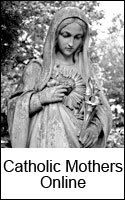The Chamorro have a legend associated with a 300 year old wooden statue of Santa Marian Kamalen.
One version of the legend of Santa Marian Kamalen is that one day a fisherman noticed the statue in the water while he was spear fishing. He swam toward it to get a closer look. Oddly though, no matter how much he tried to draw closer to it, it seemed to retreat. Every attempt to get close to the statue failed. Frustrated, he returned to land to ask the advice of the village priest.
The priest had a simple answer. He told the fisherman who fished dressed in next to nothing that he needed to only attempt to approach Our Lady's statue again fully dressed in his finest Sunday clothes.
The man listened to the priest and did just that. On that attempt he had no difficulty approaching and getting the statue.
A member of the Dotacion, the militia, the fisherman soon reported for a required two months of service. He took the statue with him. Due to the fact that the main barracks where under construction, the statue had to be placed in a tool shed.
That is where the name of the statue originated - in Spanish the word for that building that housed the statue is camarin. In the Chamorro it is a kamalen. Therefore, she is Maria del Camarin or Santa Marian Kamalen, The Lady of the Barracks.
The statue was moved to the barracks chapel when construction was completed. There she remained for almost 150 years until the militia was disbanded. At that time the Santa Marina Kamalen statue was moved to Dulce Nombre de Maria church. The church has since become a cathedral.
There have been notable times when the statue was moved from the church.
During World War II occupation of Guam by the Japanese a young woman named Mariquita Torres cared for the statue, lying to the Japanese authorities when they tried to take it. Tita, as she was called, told the soldiers that the statue was only lent to the church for special occasions.
Father Jesus Baza Duenas, who would later be beheaded by the occupiers, validated the assertion informing those in command that it was indeed property of the Torres family. When the family would be forced by bombings to go to a bomb shelters, Tita would bring the statue.
In more recent times, the statue has been stolen three times. The first two times, the statue was returned without repercussions. The thieves weren't even identified.
The recovery of the statue after the third theft occurred a little more than a month after it disappeared. While trimming plants in a park, a maintenance person looked up from his work to see someone waving at him. It was the missing statue.
The Santa Marian Kamalen statue has survived war, theft, an earthquake and fire.
The natural wear caused by the passage of time has led to the statue occasionally being removed from the church for minor repairs. The Chamorro say that one such time her face was scraped too roughly. It was then that the statue is said to have bled.
A replica of Santa Marian Kamalen is enshrined in the National Shrine of the Immaculate Conception in Washington, D.C.
Good Samaritan Hospital of Los Angeles, California will be placing a replica of Santa Marian Kamalen in the hospital's All Soul's Chapel. On September 7th, a Mass in honor of the Blessed Mother will be celebrated at the chapel. A Southern California Chamorro choir will sing at the Mass.












1 comment:
Cool story. What a beautiful statue, too---love the long, wavy hair! :)
Post a Comment